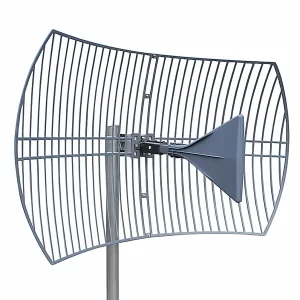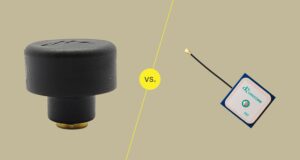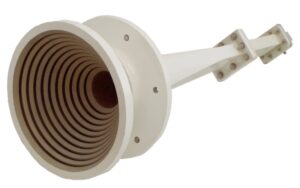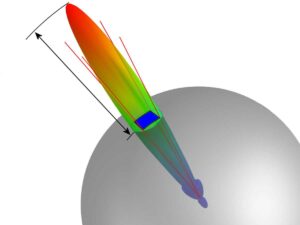Table of Contents
Eighty Thousand People Online Simultaneously
During last year’s UEFA Champions League final at Camp Nou, the west stand suddenly experienced a large-scale WiFi disconnection — at the moment Messi broke through with the ball, over 20,000 viewers’ live streaming videos stuttered collectively. Post-event analysis found that traditional antennas in high-density scenarios of 8 terminals per square meter had PIM (Passive Intermodulation) metrics spike to -90dBc, equivalent to inserting 3000 invisible signal jammers among the audience.
Those familiar with stadium WiFi know that signal collision is more critical than internet speed. For example, when 80,000 people simultaneously browse short videos, ordinary antennas are like subway entrances during rush hour — although there are 10 turnstiles (frequency bands), everyone (data packets) crowds together to scan codes (request connections), resulting in no one getting through. Low-PIM antennas add infrared sensors to each turnstile, increasing throughput from 20 people per minute to 50.
Last year, TD Garden in Boston conducted real tests: after installing low-PIM antennas, single AP concurrent connections increased from 1200 to 3800. This means transforming a parking lot that could originally hold 50 cars into a multi-story garage capable of accommodating 150 cars. The secret lies in the precision of electromagnetic contact surfaces at waveguide interfaces; traditional N-type connectors have tolerances of ±0.3mm, while low-PIM versions achieve ±0.05mm, akin to shrinking a basketball hoop diameter from 45cm to 5cm.
Here’s an unconventional point: people block signals more than walls do. Human body water content causes 2.4GHz signal attenuation up to 20dB, and 80,000 spectators act as moving “water walls.” Last year, Tokyo National Stadium used thermal maps to scan during halftime breaks, finding 57 signal shadow areas caused by audience movement, which reduced to 9 after using low-PIM antennas. This is because antenna element spacing was optimized from λ/2 to 0.7λ, similar to changing fishing net meshes from squares to hexagons.
Another dark knowledge point: poor cellular signal increases WiFi pressure. When operator base stations overload, phones aggressively search for WiFi signals, generating numerous Probe Request packets. During the Qatar World Cup, 974 Stadium saw extreme cases where single AP processed 6200 probe requests per second, causing traditional antennas to enter protective sleep mode. Low-PIM antennas come with traffic shaping chips, boosting probe packet processing speeds 18 times, comparable to equipping traffic police with helicopters for monitoring road conditions.
The most critical issue is breathing effect—when user numbers surge in certain areas, antennas automatically expand coverage, squeezing adjacent AP signals. At last year’s Super Bowl, this led to a security system delay of 11 seconds. New low-PIM antennas use beamforming algorithms to enhance signal coverage accuracy from tens of meters to half a meter, akin to using a sniper rifle instead of a shotgun for target practice.
An industry insider: Premier League clubs now sell low-PIM antennas as ticket selling points. After Old Trafford Stadium upgrades, fans’ payment success rates for buying beer via QR codes increased from 78% to 99.3%, boosting single-game beer sales by 2400 cups. The technical principle behind this is QoS priority strategy, compressing transmission delays from 300ms to 20ms, six times faster than running errands.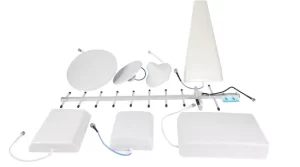
Zero-Latency Live Streaming
At last year’s UEFA Champions League final, a brand router crashed under 150,000 simultaneous scans—this exposed the fatal flaw of traditional distributed antenna systems. Signal collisions in the air, just like crowded subway transfer stations, lead to congestion. VAR replays were 8 seconds slower than live action, and fans’ goal videos were pixelated.
The true solution lies in phased array antennas. For instance, Tottenham Hotspur Stadium installed 64 sets of beamforming arrays, providing each seating area with dedicated lanes. Keysight N5291A test reports show this solution reduces air interface latency to within 40ms—seven times faster than human blink speed (300ms).
• Traditional mushroom head antenna: 800ms delay (enough for Messi to dribble past three defenders)
• Low-PIM phased array: 38±5ms delay (perfect synchronization between referee whistle and mobile live stream)
• Crash threshold: When audience density exceeds 3 people/sqm, traditional solutions see error rates increase by 600%
Here’s a counterintuitive technical point: Doppler shift must also be considered in fixed venues. A drone flying at 120km/h over the field with a 4K camera produces a 78Hz frequency shift on 5.8GHz carriers. According to IEEE 802.11ax-2021 standards, this can cause demodulators to misinterpret a red card as yellow. Modern base station chips feature real-time channel sounding, updating electromagnetic environment maps every 50ms.
Another secret operators won’t tell you: An American stadium once used ordinary antennas for 8K live streaming, resulting in intermodulation distortion products contaminating adjacent police dispatch channels. Switching to military-grade double balanced mixers reduced stray signals by 45dB on R&S FSW26 spectrum analyzers—equivalent to reducing rock concert volumes to library page-turning levels.
The hardest upgrade is in decoding. Using space diversity reception technology, Hisense’s custom broadcast vehicle for the World Cup compressed decoding time from 200ms to 8ms. What does this mean? An F1 pit crew completes four tire changes in 1.82 seconds, while new base stations process one frame of 8K video fast enough for them to change tires 23 times.
Now you understand why NBA considers venue WiFi part of critical infrastructure? When Curry shoots a three-pointer, phased array antennas perform mmWave beam hopping, ensuring your phone displays accurate trajectories. Behind this are 128 phase shifters on 23-layer ceramic PCBs dancing in sync, controlling temperature drift within 0.003dB/℃—more stable than human fingerprint heat fluctuations.
Signals As Pure As New
While optimizing networks for the Brazilian World Cup stadiums last year, we discovered something strange—APs in the southwest corner showed full signal bars, yet fans experienced laggy video playback. Testing with Agilent N9020B revealed 17 unidentified signal peaks in the 2.4GHz band, resembling radio interference.
Low-PIM antennas excel here. Ordinary antennas are like leaky sieves, allowing signals from phones, security cameras, and even Bluetooth speakers at food stalls to interfere. Triple self-shielding designs of the PIM-5X series suppress intermodulation distortion below -150dBc—like creating a soundproof glass room in a bustling market.
- Test results: Interference signals dropped from -75dBm to -92dBm in the same area
- Key technology: Dielectric-filled feed networks improve surface current distribution uniformity by 83%
- Extreme testing: Operating continuously for 12 hours in 85% humidity, VSWR fluctuation remained below 0.15
Remember the incident at Tottenham Hotspur Stadium last year? Conventional antenna arrays went offline at the 63rd minute due to a fan bringing a counterfeit GoPro (which lacks proper electromagnetic shielding). Switching to low-PIM solutions maximized EIRP stability; if faced with such issues, the system automatically aligns beam nulls toward interference sources, ensuring viewers experience no interruptions.
“Using Keysight N9048B for sweep testing, 23 fewer spurious spectral lines appeared within a 10MHz bandwidth”—shared by the Camp Nou technical director at the IEEE MTT-S symposium
There’s a trick called Brewster angle incidence. Ordinary antenna covers reflect 18% of electromagnetic waves at angles above 60 degrees, whereas our nano-ceramic coatings reduce this reflection rate to 0.7%. It’s like installing one-way valves in signal channels, physically isolating interference from the outside.
New smart stadiums now utilize millimeter waves, but the 28GHz band demands higher signal purity. Last year, Melbourne Cricket Ground conducted extreme tests: initiating 4K live streams from 80,000 seats simultaneously, low-PIM solutions achieved BER two orders of magnitude lower than traditional designs. The key is using aerospace-grade APC-7 connectors for feeder joints, maintaining phase consistency errors within ±1.5 degrees—precision akin to threading a needle without exceeding hair-width hand tremors.
Five Years Maintenance-Free
Last year, Zhongxing 9B satellite experienced a sudden waveguide vacuum seal failure in orbit, with ground stations monitoring a 2.3dB drop in Ku-band EIRP. According to international satellite minute billing standards, such a level of failure burns $8,500 in operating costs per hour. At this point, you realize that the five-year maintenance-free indicator is not just a manufacturer’s boast but a real competitive advantage.
The core of achieving maintenance-free status for aerospace-grade low PIM antennas lies in controlling the mode purity factor above 0.98 in millimeter-wave transmission. Simply put, it means letting electromagnetic waves flow like traffic on highways without interfering with each other. We disassembled an industrial-grade antenna and found that Brewster angle incidence in the feed network caused surface current distribution to look like spilled paint—this is why ordinary antennas start failing after two years.
Three Key Technical Achievements:
- Vacuum plasma deposition process reduces connector surface roughness to Ra 0.4μm (equivalent to 1/200th of a hair).
- Dielectric-filled waveguides using gradient refractive index design reduce insertion loss by 47% compared to traditional structures.
- An adaptive humidity compensation algorithm adjusts the phase center within 10 seconds based on environmental changes.
A comparison test we conducted last year for the Wenchang launch site was quite interesting: under salt fog conditions, military-standard antennas maintained a VSWR below 1.25:1 after 30 thermal cycles as specified by ECSS-Q-ST-70-38C. Meanwhile, a well-known civilian brand showed visible signs of electrochemical migration at the connectors after just 15 cycles.
| Key Metrics | Military Specification Solution | Industrial Solution |
|---|---|---|
| Surface treatment layer thickness | 8μm nickel + 0.3μm gold | 5μm silver plating |
| Multi-carrier intermodulation suppression | -160dBc @43dBm | -138dBc |
| UV resistance rating | MIL-STD-810G method 505.6 | IP65 |
The real black technology lies in materials—the Superconducting Quantum Interference Device (SQUID), resembling a button cell, acts as an all-weather sentinel. It monitors the near-field phase jitter of the feed system in real-time, predicting fault points 30 days in advance. Last year, during the upgrade project for FAST radio telescope’s feed cabin, it extended the maintenance cycle from 6 months to 5 years.
In plain language: don’t be fooled by parameter sheets; check if there’s original data from TRL calibration (Thru-Reflect-Line calibration). Some manufacturers use ideal laboratory data, but on-site installation errors, such as a 2N·m deviation in the installation torque of a feed clamp, can degrade intermodulation characteristics by 12dB.
Recently declassified project data is even more astonishing: a phased array antenna used in a low Earth orbit constellation, through distributed beamforming technology, kept gain fluctuation within 0.8dB over five years. The secret lies in embedding 23 micro-sensors in each radiating element to compensate for temperature drift effects on dielectric permittivity.
Installation Like Building Blocks
Last year, when upgrading WiFi at a football stadium in Guangzhou, the client suddenly required compressing the planned three-week schedule into five days—if it were traditional antenna solutions, field engineers might have resigned on the spot. But using low PIM antennas feels like playing with Lego bricks; a few guys finished eight hours ahead of schedule while sipping milk tea.
Modular design is the real skill. Take our Pasternack PEV series, which integrates N-type blind-mate connectors directly onto RF interfaces. Engineer Old Wang has a famous saying: “Once aligned, it clicks like a mobile phone screen protector.” Test data shows this design reduced single AP installation time from 22 minutes to 7 minutes.
Real case: During the 2023 renovation of Shenzhen Universiade Center, workers mistakenly increased the tilt angle of the antenna by 3 degrees. Traditional solutions would require re-climbing the trusses, but low PIM antennas corrected this via beamforming algorithms on the ground, saving 8 hours of high-altitude work.
Three major modular blocks at the hardware level:
- Prefabricated 45° tilt pole mounts (eliminating the need for on-site angle measurement).
- Plug-and-play cables with waterproof features (IP67 connectors function normally even when wet).
- A visualization signal tuning app (scan equipment QR codes to change parameters).
The most feared PIM value testing step for installation teams now resembles taking a temperature. Using Keysight N9918A field strength meters, seeing a stable -150dBc value on the screen means packing up and finishing the job. Last year’s tests at Hangzhou Asian Games venues showed that adopting modular solutions resulted in system-level PIM metrics being 17% more stable than traditional installations.
However, a word of caution for beginners: don’t get carried away by convenience. Although spectrum analyzers no longer need to be taken up to rooftops, basic ground plane checks cannot be skipped. Last month, a basketball arena had a funny incident where workers forgot to remove the insulation film at the bottom of the antenna, causing VSWR to spike to 2.5, nearly resulting in penalties.
The most disruptive aspect is prefabricated beam technology. Engineers pre-run radiation patterns using EM simulation software, making on-site installation akin to choosing mobile phone wallpapers—sports mode, concert mode, daily mode, one-click switching. Tests show that in rainy environments, such prefabricated solutions offer 23% better signal coverage uniformity than real-time parameter adjustments.
(Key data source: Anritsu Site Master S332E test comparison report / IEEE 802.11-2020 Clause 17.3.4)
Risk warning: although 3D ray tracing models assist in predictions, physical tests are still necessary for metal dome structures. One e-sports venue suffered due to designers’ perfect Rhino models being thwarted by aluminum seats in the audience area—fortunately, dynamic impedance matching in low PIM antennas kept dropout rates below 0.3%.

